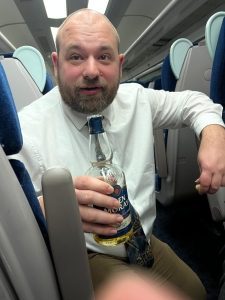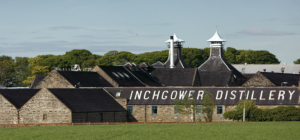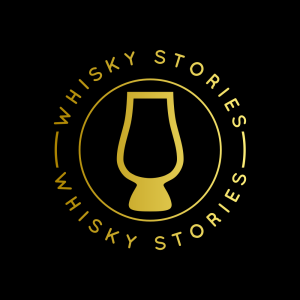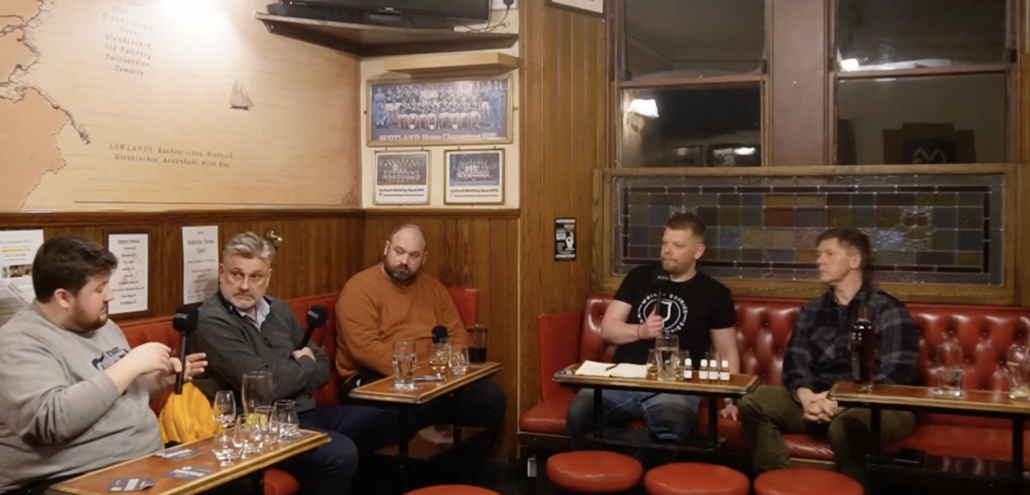Good to be back!
This was our first podcast recording of the year!
Fresh from my adventures in India, we were rested and eager to return to Diggers for drams and recording.
And what an episode to come back to!
I’ll split this recording into two blog posts, as both guests deserve their own write-up.
We were joined by Stephen Woodcock who is Head of Whisky Creation and Stocks for Glen Turner.

Angus enjoying a bottle of Glen Moray on a train trip back from Inverness (when drinking on trains was legal!)
How did it all begin?
Stephen’s journey into whisky is a great story, he has a real skill in how he talks about whisky.
Glen Turner may not be a name that many of us are familiar with. Thanks Head of Research – Angus, he was able to inform us that Glen Turner own the following brands:
- Glen Moray Single Malt Distillery
- Cutty Sark Blended Scotch
- Label 5 Blended Scotch
- Sir Edwards Blended Scotch
- Starlaw Single Grain Distillery
Glen Moray holds ‘cult hero’ status on the podcast thanks to Ali Baxter who could see the distillery from his bedroom window. Mark Davidson who could see Ali Baxter’s house from his bedroom window… (one of the funniest moments on the pod).
Growing up in North Ayrshire, his fascination with the massive chemical plants around him sparked a love for chemistry, leading to a career in the chemical industry.
Despite his mother working for Ballantine’s and his father owning a bar, he didn’t like a dram.
But alas, socio-economic factors led to the decline of these huge chemical plants in Scotland and led to Stephen looking for new opportunities.
Having moved away from lab work, he had become experienced in Plant Management which was the role he was to take when he began his career in whisky with Diageo.
The job was to be looking after pre-distillation for the Port Dundas Distillery in Glasgow.
Port Dundas is no longer in operation, but at the time it was one of the main sources of single grain whisky for Diageo. Stephen explains that up until the distillery was closed, it was producing 40 to 5o million litres a year.
This transition shouldn’t have been hard for Stephen, as grain distilleries are massive industrial plants, much like the chemical ones he’d worked in before.
However, things weren’t to be as straight forward and a week before he began his new job, he was asked to run the on-site cooperage.
“I didn’t know a hogshead to a hogs arse”
Transitioning from the mass production and automation of spirit production to the timeless craft of hand-building casks highlights a key truth: no matter how advanced the processes become, the human element remains essential in transforming spirit into whisky.
Stephen even highlights the importance of the Coopers role in making casks by explaining that each stave is also hand selected and that some Coopers will serve a 9 year apprenticeship before they are adequately qualified in the ancient craft.
Moving into Malt Distilling
When Port Dundas was closed, Stephen got the opportunity to move north and enter into the world of malt distilling.
His first posting was as Site Operations Manager of Inchgower Distillery.
“The only way that you could describe Inchgower is if you took the constituent parts of a distillery up in an aeroplane and just kicked them out”
Inchgower is a closed distillery and used within Diageo blends – mainly Bell’s.
Stephen explains that during the 1960’s Bell’s wanted to upgrade the distillery, but didn’t want to stop production. This led to a distillery with little automation and equipment in places they shouldn’t be.
Stephen shared great stories from Inchgower, where he learned whisky-making from those relying on hands-on skills and intuition.
Stephen was able to convince the senior executive team of Diageo to invest in bringing the distillery up to the standards expected with Diageo.
This involved stripping the distillery right back and rebuilding it all from scratch over a 6 month period.

Inchgower Distillery Credit – https://thewhiskyphiles.com/index/inchgower/
Creating Distillery Character
After Inchgower, it was off to Mannochmore Distillery for Stephen.
His challenge was a fairly large snagging list as well as the challenge of maintaining a consistent distillery character.
It was then a dream job at the picturesque Blair Athol Distillery in Perthshire.
I was curious to know what it was about whisky that has drawn Stephen into the wonderful world of whisky. Considering that before he began working in the industry, he openly admitted to not like whisky.
“The number of things you can do with three raw materials and understanding distillery character”
The process of creating whisky and distinct distillery character is so clear to see when talking to Stephen.
“I could talk about it all day. I love it. My longest distillery tour is seven hours”
Form Diageo, it was time to move on to a new challenge and Stephen was off to Deanston Distillery to work with Distell who own Deanston, Tobermoray and Bunnahabhain.
Stephen was asked a question before he joined Distell about taking a distillery apart, what would be the first thing that he considers. His answer was straight to the point; “Distillery Character”.
Stephen was responsible for all three distilleries but was based out of Deanston.
One of the interesting things he spoke about was how important it was to have all three distilleries communicating with each other on a regular basis.
Sharing insights and challenges between the three, very different, distilleries meant that everyone could learn from each other through shared experiences.
Glen Turner
It was from Distell where Stephen moved on to Glen Turner which is where he is today working as Head of Whisky Creation and Stocks.
We talked about the challenges we are beginning to see within the industry; prices and costs for production have risen massively.
Stephen explained that just four years ago, the cost of a first fill bourbon cask was $40 whereas today it would be costing in the range of $200.
Yet despite the raise in prices across the board in whisky, the Glen Moray brand has remained a competitively priced whisky.
Stephen mentioned some of the stock that he has at his disposal up in Elgin with Glen Moray and mentioned that there will be some exciting things to come out of the distillery over the next year or so.
Stephen’s What3Drams
Cutty Sark Original
Going full circle, Stephen can remember the iconic green bottle with the yellow label on the back bar of his fathers pub and also on his grandfathers drinks shelf. And now here he is responsible for the production of the iconic brand of whisky.
Laphroaig
This was Stephen’s introduction to whisky, and it was the whisky that made him decide that he actually love a dram.
Described as; “a fire in an oil drum, washed up on a west coast beach. But in a good way..” and “like sooking a burnt stick, but in a good way”.
Bunnahabhain 18
Bringing happy memories to his mind when having a dram and a sense of pride of being involved directly in the production of the iconic whisky brand.
This really was an incredible episode to record.
The experience that Stephen has had and the huge brands that he has been involved in was incredible to hear about.
You can watch this full episode on our YouTube Channel
Listen to the full episode HERE
You can also find Stephen on Instagram @glen_moravain



